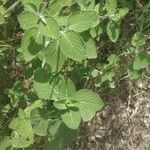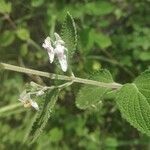Shrubs erect, much branched, to 1.5 m tall; branchlets slender, densely stellate tomentose. Stem leaves opposite; petiole 2-10 mm, densely tomentose; leaf blade ovate to elliptic, 1-3.5 × 0.5-1.8 cm, papery, rugose, adaxially olive green, densely stellate tomentose, abaxially gray tomentose, base broadly cuneate to rounded, margin crenulate, apex obtuse; lateral veins 4-or 5-paired, immersed adaxially, elevated abaxially. Cymes axillary, pedunculate, in stellate tomentose panicles, basal cymes long branched to 21-or more flowered, apical cymes 3-5-flowered; floral leaves slightly longer than cymes, upper ones much shorter, subsessile, ovate. Pedicel 2-3 mm. Calyx campanulate, ca. 2 mm, densely stellate tomentose outside; teeth broadly triangular, subequal, minute, ca. 1/3 as long as calyx tube; fruiting calyx slightly dilated, tubular-campanulate, slightly curved, ca. 3 mm, conspicuously 10-veined. Corolla white, tinged rose, or dark lilac on upper lip, ca. 7 mm, sparsely stellate tomentose outside, glandular, tube ca. 3 mm. Stamens included. Style included. Nutlets dark brown, triquetrous, oblong, ca. 1.5 mm, glabrous. Fl. Jul-Sep, fr. Aug-Oct.
More
A shrub. It is erect and has many branches. It grows to 1.5 m high. The small branches are slender. The stem leaves are opposite. The leaf stalk is 2-10 mm long. It is densely hairy. The leaf blade is oval and 1-3.5 cm long by 0.5-1.8 cm wide. It is papery. The edges are irregular. The flowering stalks near the base have up to 21 flowers while those near the tip have 3-5 flowers. The flower is white tinged with red. The nutlets are dark brown. They are 3 sided.


